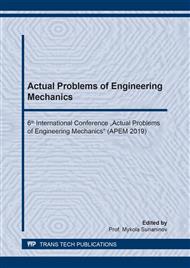p.89
p.96
p.107
p.115
p.122
p.131
p.143
p.153
p.161
Ultrasonic Control of the Formation of Gypsum Binders
Abstract:
This paper presents the research method of hardening process of gypsum binders and composites, based on them, using the ultrasonic method. Modern construction composites, based on higher water resistance gupsym, contain the coarse aggregate particles, giving them heat and sound insulating properties. One of the frequent purposes, designing such composites, is the slowdown of the processes of setting, so it allows the builders to work with the material for a sufficiently long period. The use of standard control penetration methods of the setting processes for the considered composites becomes difficult because of the presence of course particles in the binder paste. The ultrasonic method is proposed to use alternatively to study the process of setting. For its implementation, the technique has been developed, based on the use of ultrasound systems for quality control of concrete products. The transit time of ultrasonic signals through the layer of hardening binder paste with the fixed thickness was measured in a regular intervals until completely setting. On the basis of the obtained data, the ultrasound velocity was calculated and the setting time was determined. For this purpose, a differential curve of the time of ultrasound transmission was plotted, and the period was considered, at which the transition to the steady-state condition was carried out, it is equivalent to the end of the setting. The initial setting was determined by the first trip of the measuring equipment, corresponding moment of the formation of the primary crystal structure of the composite, which has sound-transmission properties. To verify the values of the setting time, the simultaneous measurement of the plastic strength of the model system was used. The moments of the beginning and the end of the setting, as well as the ultrasound velocities which were typical for these moments, were determined with the plastic strength. The obtained velocity values allowed to find the setting times of other composites. The actual setting time is estimated based on the values, obtained by all the available methods. The model, based on percolation theory, has been proposed for analyzing the physicochemical phenomena during the setting.
Info:
Periodical:
Pages:
122-127
Citation:
Online since:
August 2019
Authors:
Keywords:
Price:
Сopyright:
© 2019 Trans Tech Publications Ltd. All Rights Reserved
Share:
Citation:


